Siemens GIGASET A495, GIGASET A490 Operating Manual
Issued by
Gigaset Communications GmbH Frankenstr. 2a
D-46395 Bocholt
Manufactured by Gigaset Communications GmbH under trademark license of Siemens AG.
As of 1 Oct. 2011 Gigaset products bearing the trademark 'Siemens' will exclusively use the trademark 'Gigaset'.
© Gigaset Communications GmbH 2010 All rights reserved. Subject to availability. Rights of modification reserved. www.gigaset.com
This user guide is made from 100% recycled paper.
A31008-M2200-A601-3-ZU19
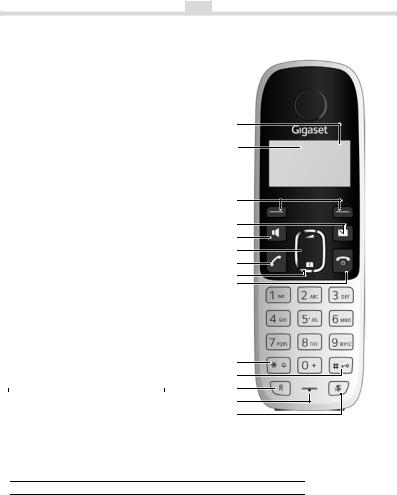
1
Gigaset A490/A495
The handset at a glance
1 |
Charge status of the batteries |
|
|||
2 |
Answering machine icon (A495 only) |
|
|||
3 |
Display keys |
1 |
|||
4 |
Message key |
|
|||
|
Flashes: new messages received |
2 |
|||
5 |
Handsfree key |
|
|||
6 |
Control key (u) |
|
|||
7 |
Talk key |
|
|||
8 |
Directory key |
3 |
|||
|
(press down on the control key) |
4 |
|||
9 |
End call key and |
||||
|
On/Off key |
5 |
|||
10 |
Ringer tone on/off |
6 |
|||
|
(press and hold in idle status) |
7 |
|||
11 |
Keypad lock on/off (press and hold) |
8 |
|||
12 |
Recall key |
9 |
|||
|
|||||
|
- Consultation call (flash) |
|
|||
|
- Dialling pause (press and hold) |
|
|||
13 |
Microphone |
|
|||
14 |
"Microphone off" key |
|
|||
|
|
|
|
|
10 |
|
|
|
|
|
11 |
|
|
Please note |
|
|
12 |
|
|
|
|
||
Charge the handset for |
|
13 |
|||
18 hours before first use. |
|
14 |
|||
|
|
|
|
|
|
± U
11.12. 11:56
INT MENU
Display key on handset:
Pressing a key launches the function that appears above that key in the display.
Display |
Function when pressed |
INT |
Call other registered handsets ¢page 14. |
MENU |
Open main/submenu (see Menu tree ¢page 25). |
“ |
Go back one menu level. |
U |
Scroll up/down or adjust volume with u. |
T |
Move cursor to left/right with u. |
˜ |
Backspace deletes one character at a time. |
OK |
Confirm menu function or save entry. |
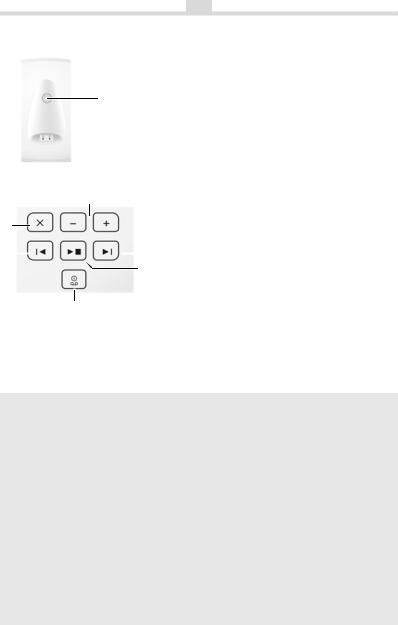
2
The base station at a glance
1
A495 only:
3
5
6 |
|
|
|
7 |
|
|
4
2
1 Registration/paging key:
(press briefly, "Paging" ¢page 13) Register handsets¢
(press and hold page 13).
2On/Off key: activate and deactivate answering machine.
Lights up: answering machine is activated. Flashes: answering machine is operating.
3Volume keys: (– = quieter; + = louder) During message playback: adjust the speaking volume.
While phone is ringing: adjust ringer volume.
4Play/Stop key:
Play back messages from the answering machine, or cancel playback.
Flashes: new messages available. Flickering: memory is full.
During message playback:
5 Delete current message.
6Skip to the start of the current message (press once) or go to the previous message (press twice).
7 Skip to next message.
ECO DECT
You are helping to protect the environment with your Gigaset A490/A495.
Reduced energy consumption
Your telephone has an energy-saving adapter plug and uses less energy.
Reduced transmission power
The transmission power of your telephone is reduced automatically:
The handset's transmission power is reduced depending on the distance to the base station. The transmission power on the base station is reduced to almost zero when only one handset is registered and the handset is in the base station.
You can reduce the transmission power of the handset and base station even more by using Eco Mode (see Menu tree page 26):
70% transmission power reduction in standby mode (top left display icon ½) and during a call. The range of the base station is reduced. Press and hold the talk key cto check that the base station can be reached. You will hear the ringing tone if the base station can be reached.
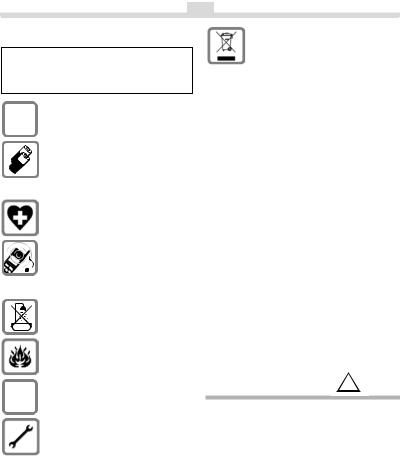
3
Safety precautions
Read this user guide and the safety precautions carefully before use. Explain their contents and the potential hazards associated with using the telephone to your children.
Only use the mains unit supplied.
$
Fit only the recommended,¢ rechargeable batteries ( page 16), i.e. never use a conventional (non-rechargeable) battery or other battery types as this could result in significant health risks and personal injury.
The operation of medical appliances may be affected. Be aware of the technical conditions in your particular environment, e.g. doctor's surgery.
Do not hold the rear of the handset to your ear when it is ringing. Otherwise you risk serious and permanent damage to your hearing.
The handset may cause an unpleasant humming noise in hearing aids.
Do not install the phone in a bathroom or shower room. The handset and base station are not splashproof.
Do not use your phone in environments with a potential explosion hazard, e.g. paint shops.
ƒIf you give your Gigaset to someone else, make sure you also give them the user guide.
Please remove faulty base stations from use or have them repaired by Gigaset service, as they could interfere with other wireless services.
Disposal
Batteries should not be disposed of in general household waste. Observe the local waste disposal regulations, details of which can be obtained from your local authority or the dealer you purchased the product from.
All electrical and electronic equipment must be disposed of separately from general household waste using the sites designated by local authorities. The appropriate disposal and separate collection of used equipment serve to prevent potential harm to the environment and to health. They are a precondition for the re-use and recycling of used electrical and electronic equipment.
For further information on disposing of your used equipment, please contact your local authority, your refuse collection service or the dealer you purchased the product from.
Emergency numbers¢ cannot be dialled if the keypad lock ( page 1) is activated!
Not all of the functions described in this user guide are available in all countries.
Care
Wipe the base station, charging cradle and handset with a damp cloth (do not use solvent) or an antistatic cloth.
Never use a dry cloth. This can cause static.
Contact with liquid !
If the handset has come into contact with liquid:
1Switch off the handset and remove the battery pack immediately.
2Allow the liquid to drain from the handset.
3Pat all parts dry, then place the handset with the battery compartment open and the keypad facing down in a dry, warm place for at least 72 hours (not in a microwave, oven etc.).
4Do not switch on the handset again until it is completely dry.
When it has fully dried out, you will normally be able to use it again.

4
First steps
Check the package contents
One Gigaset A490/A495 base station,
one power adapter
one Gigaset A49H handset,
one phone cord,
two batteries,
one battery cover,
one user guide.
If you have purchased a model with multiple handsets, the package should contain two batteries, a battery cover and a charging cradle with power adapter for each additional handset.
Setting up the base station and charging cradle (if included)
The base station and charging cradle are designed for use in enclosed dry rooms
¤Set up the base station at a central location on a flat, non-slip surface in your house or apartment.with a temperature range of +5 °C to +45 °C.
Please note
Pay attention to the range of the base station.
This is up to 300 m in unobstructed outdoor areas and up to 50 m inside buildings.
The phone's feet do not usually leave any marks on surfaces. However, due to the multitude of different varnishes and polishes used on today's furnishings, the occurrence of marks on the surfaces cannot be completely ruled out.
You can also mount the base station and charging cradle on the wall.
Please note:
Never expose the telephone to the influence of heat sources, direct sunlight or other electrical devices.
Protect your Gigaset from moisture, dust, corrosive liquids and fumes.
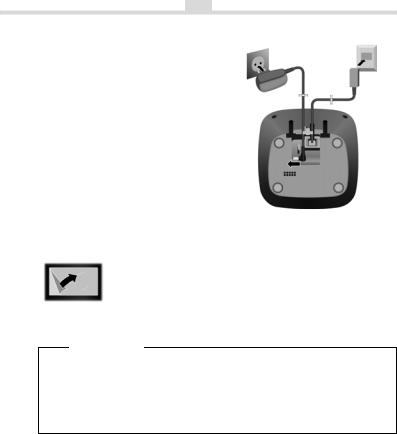
5
Connecting the base station |
|
|
|
¤ Connect the plug from the power |
3 |
||
supply 1. |
|||
¤ Plug the power adapter into the plug |
2 |
|
|
|
|
|
|
socket 2. |
|
|
|
¤ Then connect the telephone jack 3 |
|
|
|
and insert the cables into the cable |
|
|
|
ducts. |
|
|
|
Please note: |
|
|
|
The power adapter must always be |
|
1 |
|
connected, as the phone will not |
|
|
|
operate without mains connection.Only use the power adapter and
phone cord supplied. Pin connections on telephone cables can vary.
Setting up the handset for use
The display is protected by a plastic film.
Please remove the protective film!
Inserting the batteries and closing the battery cover
Warning
Use only¢rechargeable batteries recommended by Gigaset Communications GmbH ( page 16). Never use a conventional (non-rechargeable) battery or other battery types as this could result in significant health risks and personal injury. For example, the batteries could explode. The phone could also malfunction or be damaged as a result of using batteries that are not of the recommended type.

6
¤
¤
Insert the batteries the right way round.
The polarity is indicated in/on the battery compartment.
If you need to open the battery cover, for instance to replace the batteries, press the ribbing at the top of the battery cover and slide it downward.
¤Slide the battery cover from bottom up onto the casing until it clicks into place.
Placing the handset in the base/charger
¤ Place the handset in the base/charger with its display facing forward.
Each handset of your package is registered with the base at the factory. You do not need to register the handset again. If you wish to use your handset with a different base or¢use further handsets with your base, you have to register the handset manually ( page 13).
To charge the batteries, leave the handset in the base/charger.
Please note
Only place the handset in the designated base/charger.
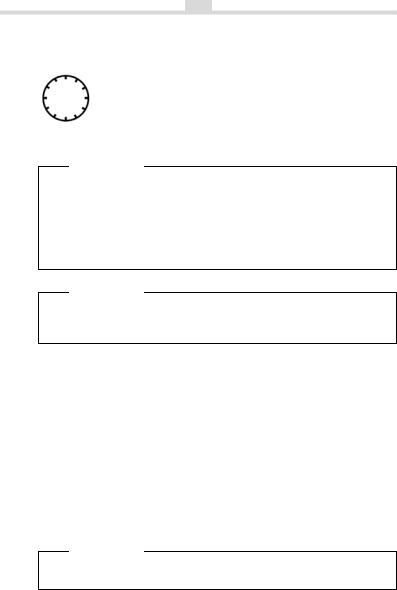
7
Initial charging and discharging of the batteries
The correct charge level can only be displayed if the batteries are first fully charged and discharged.
18h |
¤ Place the handset in the base station or charging cradle for 18 |
hours. |
|
¤ Then remove the handset from the base station or charging cra- |
dle and do not replace it until the batteries are completely discharged.
Please note
After the first battery charge and discharge you may replace your handset in the base station or charging cradle after every call.
Always repeat the charging and discharging procedure if you remove the batteries from the handset and reinsert them.
The batteries may warm up during charging. This is not dangerous.
After a while, the charge capacity of the batteries will decrease for technical reasons.
Warning
Please ensure that the handset is in the charging cradle if you are absent for a long time (e.g. during holidays) or remove the batteries from the handset. Otherwise the batteries could be damaged.
Charge status of the batteries
The charge status is indicated by the top right display icon. After the initial charging procedure a complete charging to full capacity takes at least 18 hours.
eU (flat to full)
e flashes: batteries almost flat
U flashes: charging
Setting the date and time
Set the date and time so that the correct date and time can be assigned to incoming calls, and so that the alarm can be used.
MENU¢ ¢¢Settings ¢OK ¢Date/Time ¢OK ¢
¢Date: ¢~(enter the day, month and year in 6-digit format)¢ ¢OK
Time: ~(enter hours and minutes in 4-digit format) OK a(press to return to idle status)
Please note
When entering the time and date, you can move the position of an entry to the left or right by pressing the control button up or down.
